| THE ING NEWSLETTER | No. 5, October 2001 |
|
|
SCIENCE |
|
|
|
| Previous: | The ING Red Sensitive CCD Project | Up: | Table of Contents | Next: | Dragons Breath Cooling for ING, TNG & NOT CCDs |
Other available formats: PDF
 [ TIFF ]
[ TIFF ]
First Results
from the Rayleigh Laser Guide Star Project
Paul
Clark (University of Durham)
The
Restricted Conjugate Adaptive Optics project is part of the University
of Durham Astronomical Instrumentation Group's rolling grant programme,
funded by PPARC. The project aims to demonstrate the feasibility of using
commercially available laser technology to provide a Rayleigh back-scatter
laser guide star system for use with Adaptive Optics. In particular the
project investigates low order AO correction over a wide field of view
for use with multi-object spectroscopy on the WHT.
The project is ongoing with the first (Phase A) run having been completed at the Isaac Newton Group of Telescopes on La Palma during May 2001. Launch tests were conducted using both the 4.2-m William Herschel Telescope and a custom-made 30-cm f/6 launch system housed in an outbuilding adjacent to WHT.
Figures 1
and 2 show the high power laser launch through the
30-cm f/6 launch system and the WHT. Safety considerations form a major
part of the project. The laser is only operated by trained staff using
protective goggles to prevent eye damage. A plane spotter is used to ensure
that no harm comes to aircraft that may fly through the laser beam (the
mountain top itself is actually a 'no fly' zone).
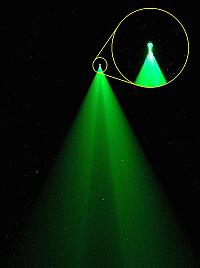 |
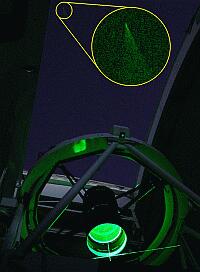 |
| Figure 1 (left). High power laser launch through the 30-cm f/6 launch system [ JPEG | TIFF ]. Figure 2. The laser launch through the WHT [ JPEG | TIFF ]. | |
The 'bow tie' structure
seen in Figure 1 is a result of focussing
the laser at a particular altitude. The laser is actually pulsed (although
the beam appears continuous to the human eye) and a high speed pockels
cell shutter is used to range-gate the return pulse at the focal height.
The focal spot then appears as a low altitude star which can be used to
correct atmospheric turbulence with an Adaptive Optics system. The novel
optical configuration used during the Phase A run is shown in Figure
3.
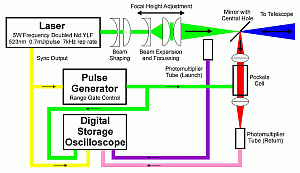 |
| Figure 3. Optical configuration used during the Phase A run [ GIF | TIFF ]. |
Fluorescence Measurement
One of the main objectives
of the WHT run was to establish if fluorescence from the telescope optics
would prevent return measurements during the next phase of the project.
The trace in Figure 4, taken just before sunrise
on May 13th using a photomultiplier tube, shows return scatter and fluorescence
from the telescope optics decaying within 2.5 µs, establishing that
return above 400 m should be observable without difficulty.
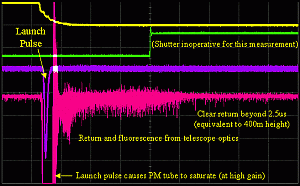 |
| Figure 4. Fluorescence measurement [ GIF | TIFF ] |
Range-Gated Return
The range-gate pockels cell
shutter was tested during the May 13th slot on the WHT. The return from
differing altitudes was observed using a photomultiplier tube looking at
the telescope via a 'mirror with a hole' (to separate launch and return
beams — see Figure 3). The 'bow tie' structure is
formed as the return passes through focus where most of the light is lost
through the hole (see Figure 5). The bow tie was
seen to change position as expected as the focal height was altered.
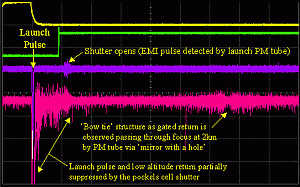 |
| Figure 5. Range-gated return [ GIF | TIFF ] |
Cloud Ceiling Detection
An interesting by-product
of the Rayleigh laser system, when used with photomultiplier return detection,
is the ability to accurately resolve cloud layers above the telescope.
The trace in Figure 6 was taken on May 15th using
the 30-cm f/6 launch system from the LN2 building. Two thin
cloud layers at 2.8km and 4.7km are clearly visible.
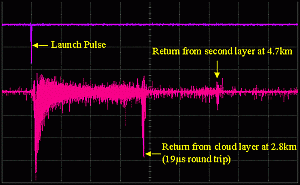 |
| Figure 6. Cloud ceiling detection [ GIF | TIFF ] |
Email contact: Paul Clark (paul.clark@durham.ac.uk)
| Previous: | The ING Red Sensitive CCD Project | Up: | Table of Contents | Next: | Dragons Breath Cooling for ING, TNG & NOT CCDs |
| GENERAL | SCIENCE | TELESCOPES AND INSTRUMENTATION | OTHER NEWS FROM ING | TELESCOPE TIME |